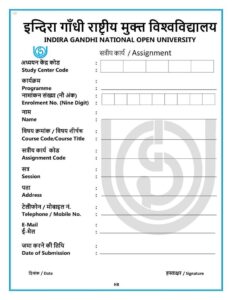IGNOU Assignments Solutions | Ignou Question Paper & Updates
Briefly discuss various stages in disaster cycle.
MPA 018 Assignment Solution | DISASTER MANAGEMENT | Briefly discuss various stages in disaster cycle…
Disaster management aims to reduce, or avoid the potential losses from hazards, assure prompt and appropriate assistance to victims of disaster, and achieve rapid and effective recovery. The disaster management cycle illustrates the ongoing process by which governments, businesses, and civil society plan for and reduce the impact of disasters, react during and immediately following a disaster, and take steps to recover after a disaster has occurred. Appropriate actions at all points in the cycle lead to greater preparedness, better warnings, reduced vulnerability, or the prevention of disasters during the next iteration of the cycle.
The complete disaster management cycle includes the shaping of public policies and plans that either modify the causes of disasters or mitigate their effects on people, property, and infrastructure. The mitigation and preparedness phases occur as disaster management improvements are made in anticipation of a disaster event. Developmental considerations play a key role in contributing to the mitigation and preparation of a community to effectively confront a disaster.
As a disaster occurs, disaster management actors, in particular, humanitarian organizations become involved in the immediate response and long-term recovery phases. The four disaster management phases illustrated here do not always, or even generally, occur in isolation or in this precise order. Often phases of the cycle overlap and the length of each phase greatly depends on the severity of the disaster.
a. Mitigation: Minimizing the effects of the disaster.
Examples: Building codes and zoning; vulnerability analyses; public education.
b. Preparedness: Planning how to respond.
Examples: Preparedness plans; emergency exercises/training; warning systems.
c. Response: Efforts to minimize the hazards created by a disaster.
Examples: Search and rescue; emergency relief.
d. Recovery: Returning the community to normal.
Examples: Temporary housing; grants; medical care.
Sustainable Development: Developmental considerations contribute to all aspects of the disaster management cycle. One of the main goals of disaster management, and one of its strongest links with development, is the promotion of sustainable livelihoods and their protection and recovery during disasters and emergencies. Where this goal is achieved, people have a greater capacity to deal with disasters and their recovery is more rapid and long-lasting.
In a development-oriented disaster management approach, the objectives are to reduce hazards, prevent disasters, and prepare for emergencies. Therefore, developmental considerations are strongly represented in the mitigation and preparedness phases of the disaster management cycle. Inappropriate development processes can lead to increased vulnerability to disasters and loss of preparedness for emergency situations.
Mitigation: Mitigation activities actually eliminate or reduce the probability of disaster occurrence, or reduce the effects of unavoidable disasters. Mitigation measures include building codes; vulnerability analyses updates; zoning and land use management; building use regulations and safety codes; preventive health care; and public education. Mitigation will depend on the incorporation of appropriate measures in national and regional development planning.
Its effectiveness will also depend on the availability of information on hazards, emerging risks, and the countermeasures to be taken. The mitigation phase, and indeed the whole disaster management cycle, includes the shaping of public policies and plans that either modify the causes of disasters or mitigate their effects on people, property, and infrastructure.
Preparedness: The goal of emergency preparedness programs is to achieve a satisfactory level of readiness to respond to any emergency situation through programs that strengthen the technical and managerial capacity of governments, organizations, and communities. These measures can be described as logistical readiness to deal with disasters and can be enhanced by having response mechanisms and procedures, rehearsals, developing long-term and short-term strategies, public education, and building early warning systems.
Preparedness can also take the form of ensuring that strategic reserves of food, equipment, water, medicines, and other essentials are maintained in cases of national or local catastrophes. During the preparedness phase, governments, organizations, and individuals develop plans to save lives, minimize disaster damage, and enhance disaster response operations. Preparedness measures include preparedness plans; emergency exercises/ training; warning systems; emergency communications systems; evacuations plans and training; resource inventories; emergency personnel/contact lists; mutual aid agreements; and public information/education.
As with mitigations efforts, preparedness actions depend on the incorporation of appropriate measures in national and regional development plans. In addition, their effectiveness depends on the availability of information on hazards, emerging risks, and the countermeasures to be taken, and on the degree to which government agencies, non-governmental organizations, and the general public are able to make use of this information. During a disaster, humanitarian agencies are often called upon to deal with immediate response and recovery.
Response: The aim of emergency response is to provide immediate assistance to maintain life, improve health and support the morale of the affected population. Such assistance may range from providing specific but limited aid, range from providing specific but limited aid, such as assisting refugees with transport, temporary shelter, and food, to establishing semi-permanent settlements in camps and other locations.
It also may involve initial repairs to damaged infrastructure. The focus in the response phase is on meeting the basic needs of the people until more permanent and sustainable solutions can be found. Humanitarian organizations are often strongly present in this phase of the disaster management cycle.
Recovery: As the emergency is brought under control, the affected population is capable of undertaking a growing number of activities aimed at restoring their lives and the infrastructure that supports them. There is no distinct point at which immediate relief changes into recovery and then into long-term sustainable development. There will be many opportunities during the recovery period to enhance prevention and increase preparedness, thus reducing vulnerability.
Ideally, there should be a smooth transition from recovery to ongoing development. Recovery activities continue until all systems return to normal or better. Recovery measures, both short and long term, include returning vital life-support systems to minimum operating standards; temporary housing; public information; health and safety education; reconstruction; counseling programs; and economic impact studies. Information resources and services include data collection related to rebuilding, and documentation of lessons learned.
Wrapped Up
- For More BSCG Assignments – BSCG Solved Assignment
- For Hand Written Assignments – Click here
For more Updates join our Telegram Group and also for your inquiry you may comment here or mail us –info@ignouassignmentssolutions.in
Telegram Group – Click Here
- assignments answer
- ignou 2021-2022 assignments answer
- ignou assignments answer
- ignou assignments solutions
- ignou masters assignments answer
- ignou mba assignments answer
- ignou mpa 018 assignments solutions
- nptel assignments answers
- various stages in disaster cycle
| M | T | W | T | F | S | S |
|---|---|---|---|---|---|---|
| 1 | 2 | 3 | 4 | 5 | 6 | |
| 7 | 8 | 9 | 10 | 11 | 12 | 13 |
| 14 | 15 | 16 | 17 | 18 | 19 | 20 |
| 21 | 22 | 23 | 24 | 25 | 26 | 27 |
| 28 | 29 | 30 | 31 | |||
Recent Posts
- IGNOU Hall Ticket June 2023 – Check TEE June 2023 Admit Card Ignou
- IGNOU BHIC 104 Previous Year Question Paper & Important Question | Arts (Honours) Ignou Question Paper
- IGNOU BHIC 103 Previous Year Question Paper & Important Question | Arts (Honours) Ignou Question Paper
- IGNOU BHIC 102 Previous Year Question Paper & Important Question | Arts (Honours) Ignou Question Paper
- IGNOU BHIC 101 Previous Year Question Paper & Important Question | Arts (Honours) Ignou Question Paper
Recent Comments
Top Categories
Sign Up to Our Newsletter!!!

Bachelor’s Degree Programme (BSCG) - PHYSIOLOGY AND BIOCHEMISTRY Solved Assignment Answer | BZYCT 135 | 2021-2022

IGNOU BEGAE 182 Previous Year Question Paper & Important Question | I.A.S.

IGNOU Assignment Front Page Format | Download Free First Page of IGNOU Assignments 2022

IGNOU BEGC 132 Previous Year Question Paper & Important Question | I.A.S.

IGNOU BHIC 102 Previous Year Question Paper & Important Question | Arts (Honours) Ignou Question Paper

Bachelor of Commerce (B.Com) - COMPANY LAW Solved Assignment Answer | BCOC 135 | 2021-2022

Bachelor of Art General & Honours (BAG) - STATE POLITICS IN INDIA Solved Assignment Answer | BPSE 143 | 2021-2022

IGNOU ECO 03 Previous Year Question Paper & Important Question | Commerce Ignou Question Paper

Bachelor’s Degree Programme (BSCG) - Plant Anatomy and Embryology Solved Assignment Answer | BBYCT 135 | 2021-2022

IGNOU BZYCT 135 Previous Year Question Paper & Important Question | I.A.S.

Explain various rescue methods.

Evaluate the guiding principles for shelter provisions.

Write a note on Community based Disaster Management (CBDM).

Briefly discuss various stages in disaster cycle.

IGNOU ECO 06 Previous Year Question Paper & Important Question | Commerce Ignou Question Paper

IGNOU ECO 05 Previous Year Question Paper & Important Question | Commerce Ignou Question Paper

IGNOU ECO 03 Previous Year Question Paper & Important Question | Commerce Ignou Question Paper






